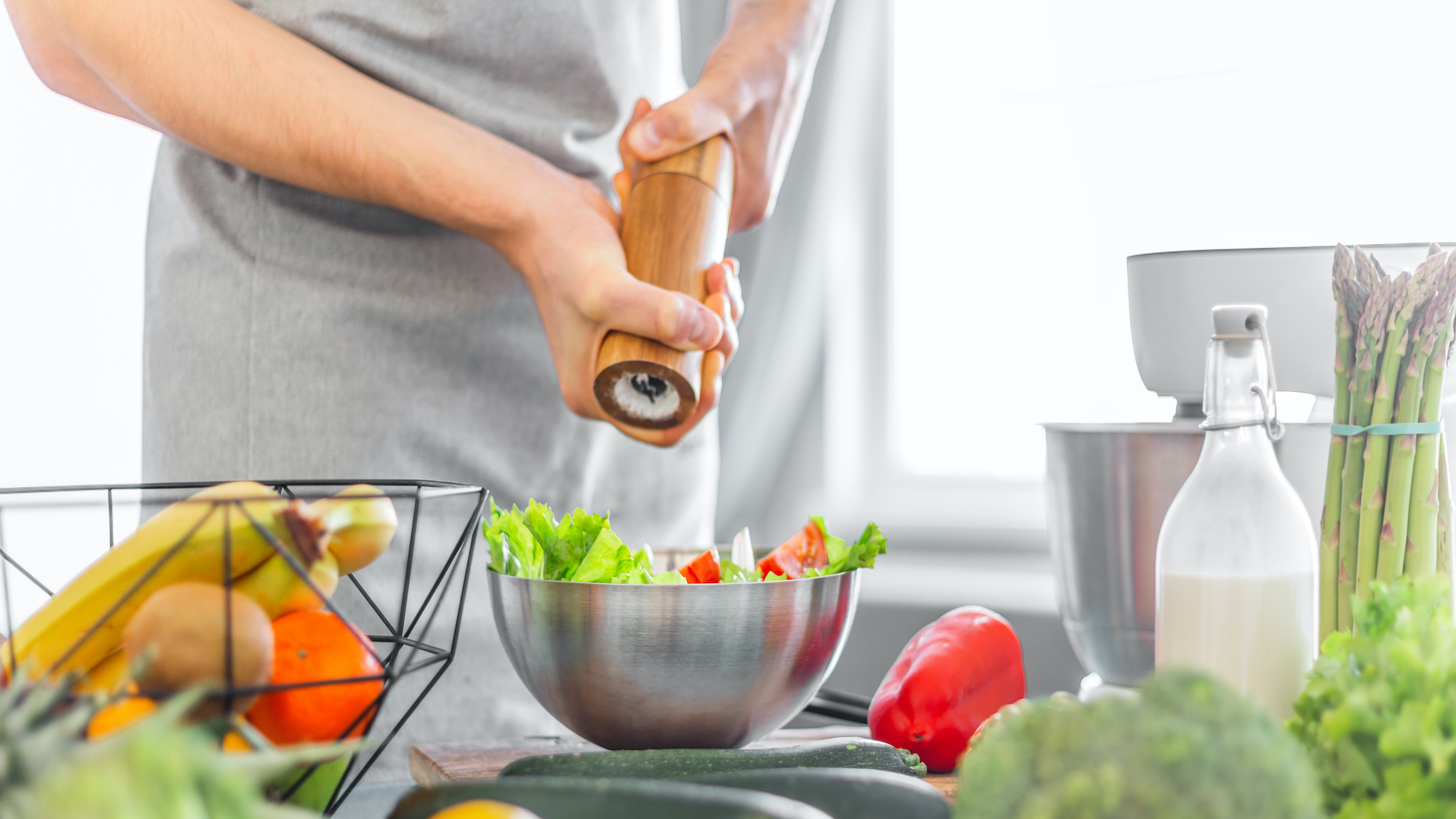You need salt to stay healthy, but unfortunately, too much of it isn't all that good.
Salt is essential for staying alive. For example, it plays important roles when it comes to nerve and brain function, blood pressure regulation, and maintaining a proper fluid balance.
But if you get too much of it, it can negatively affect your blood pressure and increase your risk of heart disease or certain cancers.
Thankfully, there are many delicious ways to flavour your dishes and enjoy wholesome meals without going overboard with the salt. Here are our favourite ideas!

1: Swap pre-made for homemade sauces, dips & condiments
Tomato sugo, pesto, mayonnaise, hummus, aioli... There are countless types of sauces, dips and condiments on the market. Unfortunately, in addition to delicious flavours, most of them also contain a lot of salt.
Thankfully, it's easy to make your own versions at home with as little — if any — salt as you'd like to add.
For example:
- Hummus: blend drained chickpeas, lemon juice, olive oil, garlic, cumin, and lemon zest until smooth. Add extra cumin, garlic, and lemon juice/zest if you want more flavour without adding salt.
- Mayo: replace mayonnaise with Greek yoghurt stirred with spices of choice. For example, mix with smoked paprika, oregano, and a dash of maple syrup for a chipotle-inspired version. Or, mix the yoghurt with crushed garlic, black pepper, and lemon juice for an aioli-style condiment.
- Tomato sugo: When making tomato sauce/sugo at home, slow cooking is the secret to rich flavour with minimal salt. Simply chop and simmer tomatoes over low heat for hours, stirring occasionally. For extra flavour, add fresh basil, cracked pepper, a dash of balsamic vinegar, and garlic.
- Pesto: store-bought pesto is incredibly high in salt. Instead, make your own by blending together plenty of fresh herbs, lemon juice, olive oil, toasted nuts, and a pinch of chilli flakes.
- Tzatziki: mix grated and drained cucumber with Greek yoghurt, crushed garlic, pepper, olive oil, lemon juice, and lemon zest.
2: Use fresh and dried herbs
If you're cooking dinner in a hurry, it can be a bit more tricky to add flavour and aroma without also adding more salt.
To spice up your meals, don't be afraid to add extra fresh or dried herbs and spices. Just be careful if using pre-made spice mixes, as some versions come with added salt.
For example, picture a potato salad with plenty of chopped parsley, a well-balanced bolognese with oregano, or a curry with a generous sprinkle of coriander — these meals will likely have lots of flavour as-is, meaning you won't be as tempted to add more salt, too.
We recommend keeping some versatile dried herbs by your stove for easy access. For example:
- parsley
- oregano
- mixed Italian herbs
- marjoram
- sage
3: Choose low-sodium products
Sometimes, you just need that soy, tamari or fish sauce in a recipe for extra 'oomph'. Similarly, stock cubes or tomato paste can do wonders when it comes to enhancing the taste of your meals.
Fortunately, most well-assorted supermarkets offer low-sodium versions of common staple items like these. Thus, simply look out for the 'low/no added salt' claims the next time you hit the shops.
The same applies for many tinned goods like tuna, beans, and vegetables; the normal versions likely contain added salt, but you'll most likely find a low-sodium version alongside them.
4: Look out for hidden salt
Major contributors to people's daily salt intake are — perhaps surprisingly — bread, baked goods, and sweets.
Even though you might not think of these items as salty foods, they often hide lots of the stuff.
Here are some common foods that may not taste overly salty, yet often contain a lot of salt:
- bread
- baked goods like muffins, biscuits and cakes
- licorice
- condiments like BBQ and tomato sauce
- pre-made soup (and pre-made/frozen meals in general)
- tinned beans and vegetables
Thus, be sure to read the labels of common foods when shopping and learn which unexpected foods are actually high contributors — or, make your own homemade versions.
5: Opt for slow cooking and umami
A sure way to add an abundance of taste with minimal salt is to cook your meals slowly.
By using a slow cooker, pressure cooker, or simmering food on the stove or in the oven for hours on end, you end up with rich, umami-packed meals without needing to add much salt.
In general, umami-rich foods like slow-cooked tomatoes, fried mushrooms, nutritional yeast, and roasted asparagus and broccoli are great additions to your low-sodium diet.
6: Change up your marinade game
Who says marinades have to be high in salt? We certainly don't! Here are some blood-pressure-friendly ideas:
- Pork: maple syrup and smoked paprika mixed and used as a glaze
- Chicken: sesame oil, garlic, ginger and honey used as an Asian marinade
- Beef: cumin, smoked paprika, pepper, chilli and oregano used as a Mexican spice rub
- Lamb: rosemary, garlic, olive oil and mint used as a Mediterranean marinade
7: Get sour
When seasoning salads, sauces, stews, or anything in between, take a moment to reflect. Could salt be replaced with acid?
Often, the answer is yes! Simply make sure to keep an assortment of sour additions at your kitchen bench for easy access and make using them a healthy habit.
Great sour additions to your cooking include:
- balsamic vinegar
- white & red wine vinegar
- lemon juice
- lime juice
8: Get rid of the shaker
If salting your meals when cooking has become a habit, or if you find yourself mindlessly adding salt to your plate before or during dinner, we have an easy fix for you: get rid of the salt shaker. (Or at the very least, pack it away and keep it somewhere inconvenient).
This way, you have to get out of your way to add more salt to your meals, which can be a great nudge that encourages you to think twice before going ahead.
There you have it, 8 ways to use less salt in cooking. Which one(s) are you going to try out first?

 view our boxes here
view our boxes here

